Comprehensive Report: Motivation Factors & Employee Job Roles
VerifiedAdded on 2023/06/05
|8
|2051
|185
Report
AI Summary
This report examines the critical role of motivation in enhancing employee effectiveness and productivity within organizations. It delves into various motivation factors such as leadership style, recognition, meaningful work, positive company culture, job advancement, financial benefits, flexible schedules, pride, and open communication. The report also explores Maslow's hierarchy of needs as a framework for understanding employee motivation. Furthermore, it analyzes the positive factors like positive values, a relaxed environment, commitment to excellence, and supportive relationships, alongside negative factors such as poor working conditions, uncompetitive culture, lack of innovation, and workplace politics that impact employee experiences. The study concludes that fostering a motivating environment is essential for achieving organizational goals and enhancing overall employee well-being, with resources available on Desklib.
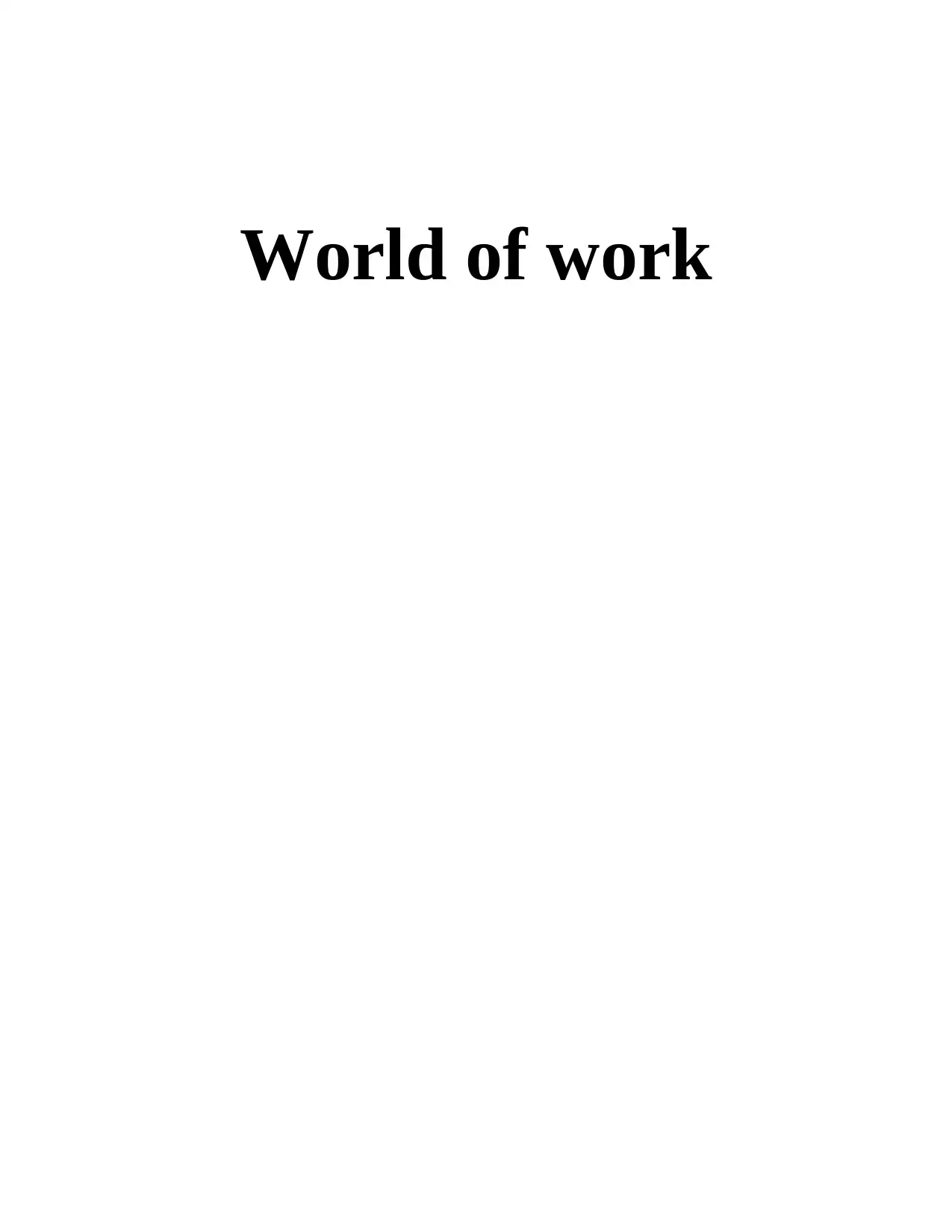
World of work
Paraphrase This Document
Need a fresh take? Get an instant paraphrase of this document with our AI Paraphraser
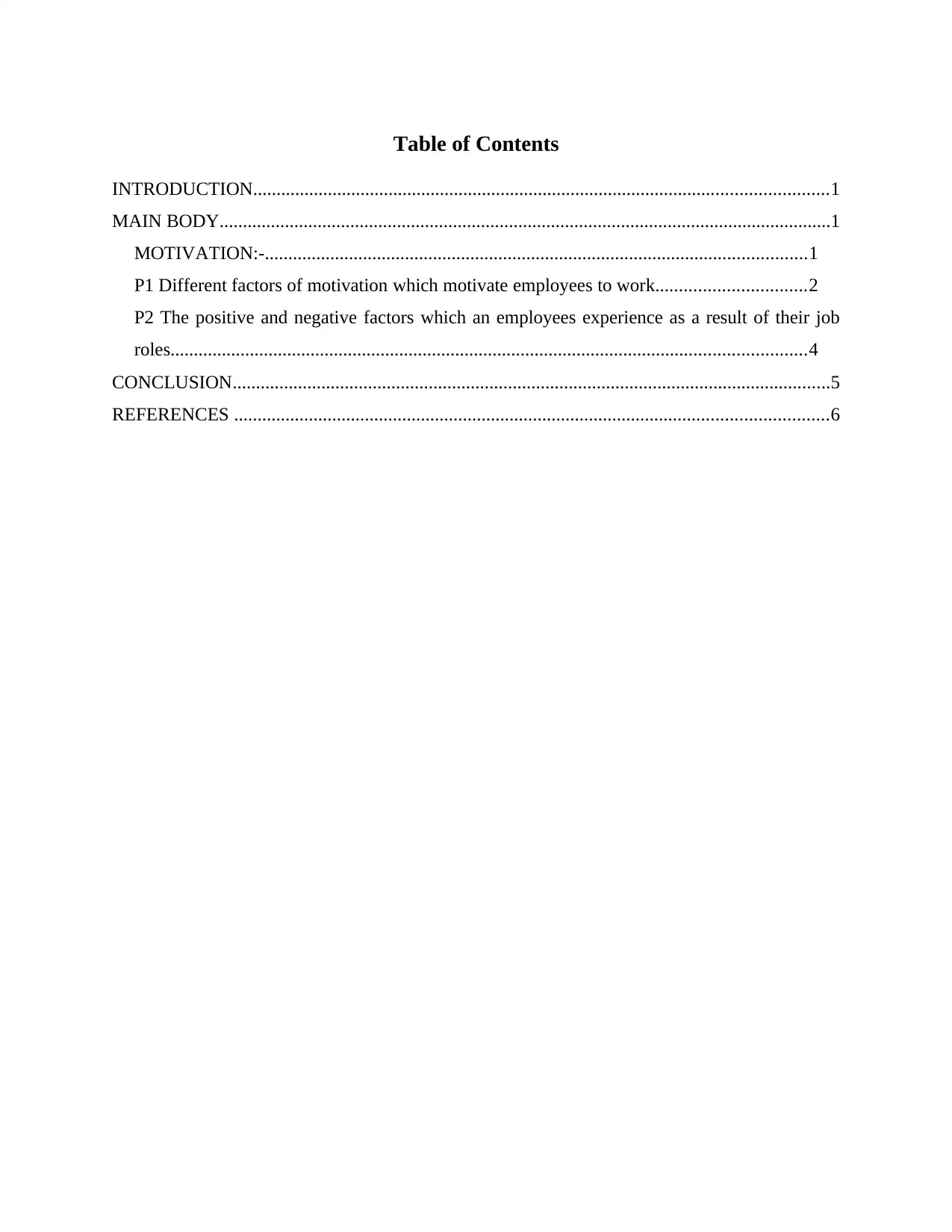
Table of Contents
INTRODUCTION...........................................................................................................................1
MAIN BODY...................................................................................................................................1
MOTIVATION:-....................................................................................................................1
P1 Different factors of motivation which motivate employees to work................................2
P2 The positive and negative factors which an employees experience as a result of their job
roles........................................................................................................................................4
CONCLUSION................................................................................................................................5
REFERENCES ...............................................................................................................................6
INTRODUCTION...........................................................................................................................1
MAIN BODY...................................................................................................................................1
MOTIVATION:-....................................................................................................................1
P1 Different factors of motivation which motivate employees to work................................2
P2 The positive and negative factors which an employees experience as a result of their job
roles........................................................................................................................................4
CONCLUSION................................................................................................................................5
REFERENCES ...............................................................................................................................6
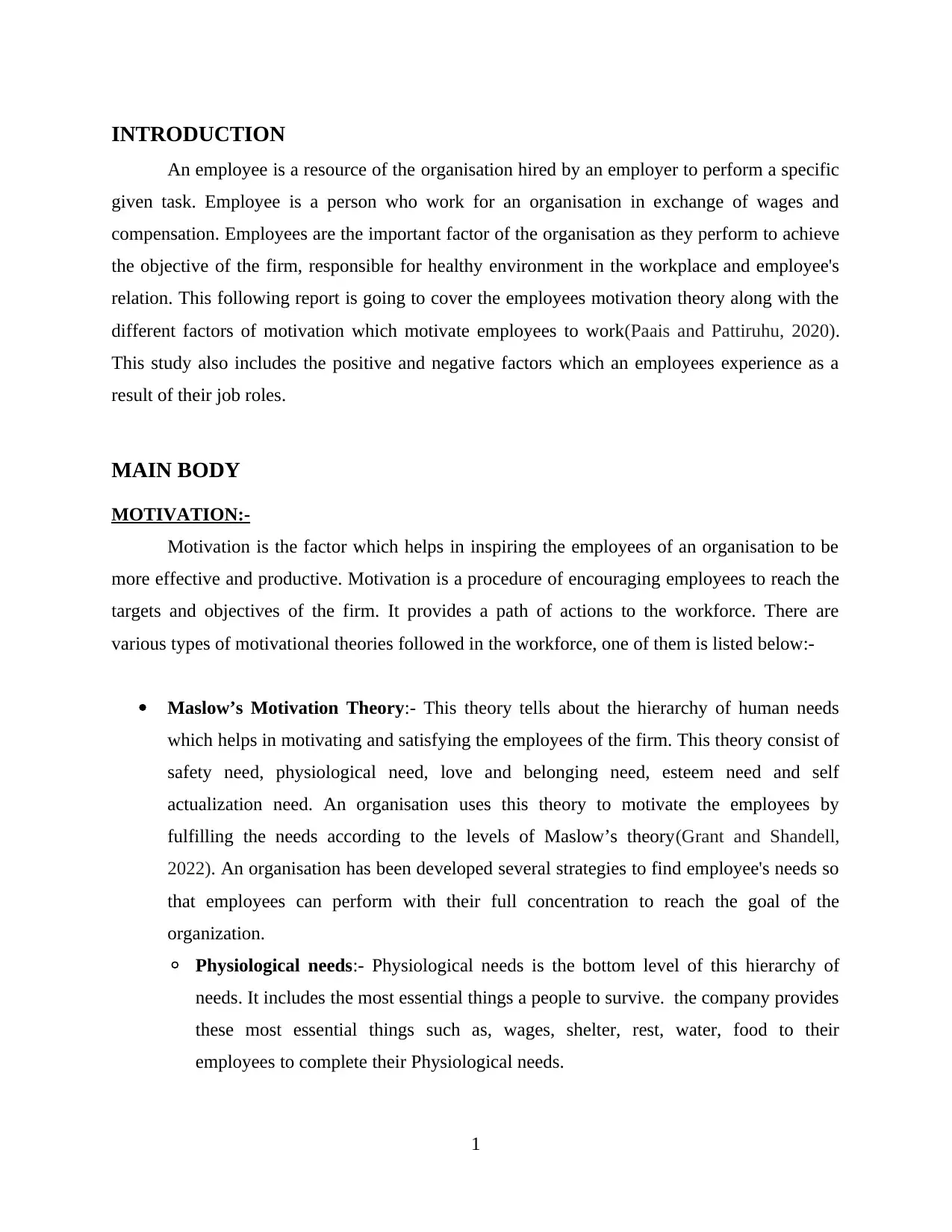
INTRODUCTION
An employee is a resource of the organisation hired by an employer to perform a specific
given task. Employee is a person who work for an organisation in exchange of wages and
compensation. Employees are the important factor of the organisation as they perform to achieve
the objective of the firm, responsible for healthy environment in the workplace and employee's
relation. This following report is going to cover the employees motivation theory along with the
different factors of motivation which motivate employees to work(Paais and Pattiruhu, 2020).
This study also includes the positive and negative factors which an employees experience as a
result of their job roles.
MAIN BODY
MOTIVATION:-
Motivation is the factor which helps in inspiring the employees of an organisation to be
more effective and productive. Motivation is a procedure of encouraging employees to reach the
targets and objectives of the firm. It provides a path of actions to the workforce. There are
various types of motivational theories followed in the workforce, one of them is listed below:-
Maslow’s Motivation Theory:- This theory tells about the hierarchy of human needs
which helps in motivating and satisfying the employees of the firm. This theory consist of
safety need, physiological need, love and belonging need, esteem need and self
actualization need. An organisation uses this theory to motivate the employees by
fulfilling the needs according to the levels of Maslow’s theory(Grant and Shandell,
2022). An organisation has been developed several strategies to find employee's needs so
that employees can perform with their full concentration to reach the goal of the
organization.
◦ Physiological needs:- Physiological needs is the bottom level of this hierarchy of
needs. It includes the most essential things a people to survive. the company provides
these most essential things such as, wages, shelter, rest, water, food to their
employees to complete their Physiological needs.
1
An employee is a resource of the organisation hired by an employer to perform a specific
given task. Employee is a person who work for an organisation in exchange of wages and
compensation. Employees are the important factor of the organisation as they perform to achieve
the objective of the firm, responsible for healthy environment in the workplace and employee's
relation. This following report is going to cover the employees motivation theory along with the
different factors of motivation which motivate employees to work(Paais and Pattiruhu, 2020).
This study also includes the positive and negative factors which an employees experience as a
result of their job roles.
MAIN BODY
MOTIVATION:-
Motivation is the factor which helps in inspiring the employees of an organisation to be
more effective and productive. Motivation is a procedure of encouraging employees to reach the
targets and objectives of the firm. It provides a path of actions to the workforce. There are
various types of motivational theories followed in the workforce, one of them is listed below:-
Maslow’s Motivation Theory:- This theory tells about the hierarchy of human needs
which helps in motivating and satisfying the employees of the firm. This theory consist of
safety need, physiological need, love and belonging need, esteem need and self
actualization need. An organisation uses this theory to motivate the employees by
fulfilling the needs according to the levels of Maslow’s theory(Grant and Shandell,
2022). An organisation has been developed several strategies to find employee's needs so
that employees can perform with their full concentration to reach the goal of the
organization.
◦ Physiological needs:- Physiological needs is the bottom level of this hierarchy of
needs. It includes the most essential things a people to survive. the company provides
these most essential things such as, wages, shelter, rest, water, food to their
employees to complete their Physiological needs.
1
⊘ This is a preview!⊘
Do you want full access?
Subscribe today to unlock all pages.

Trusted by 1+ million students worldwide
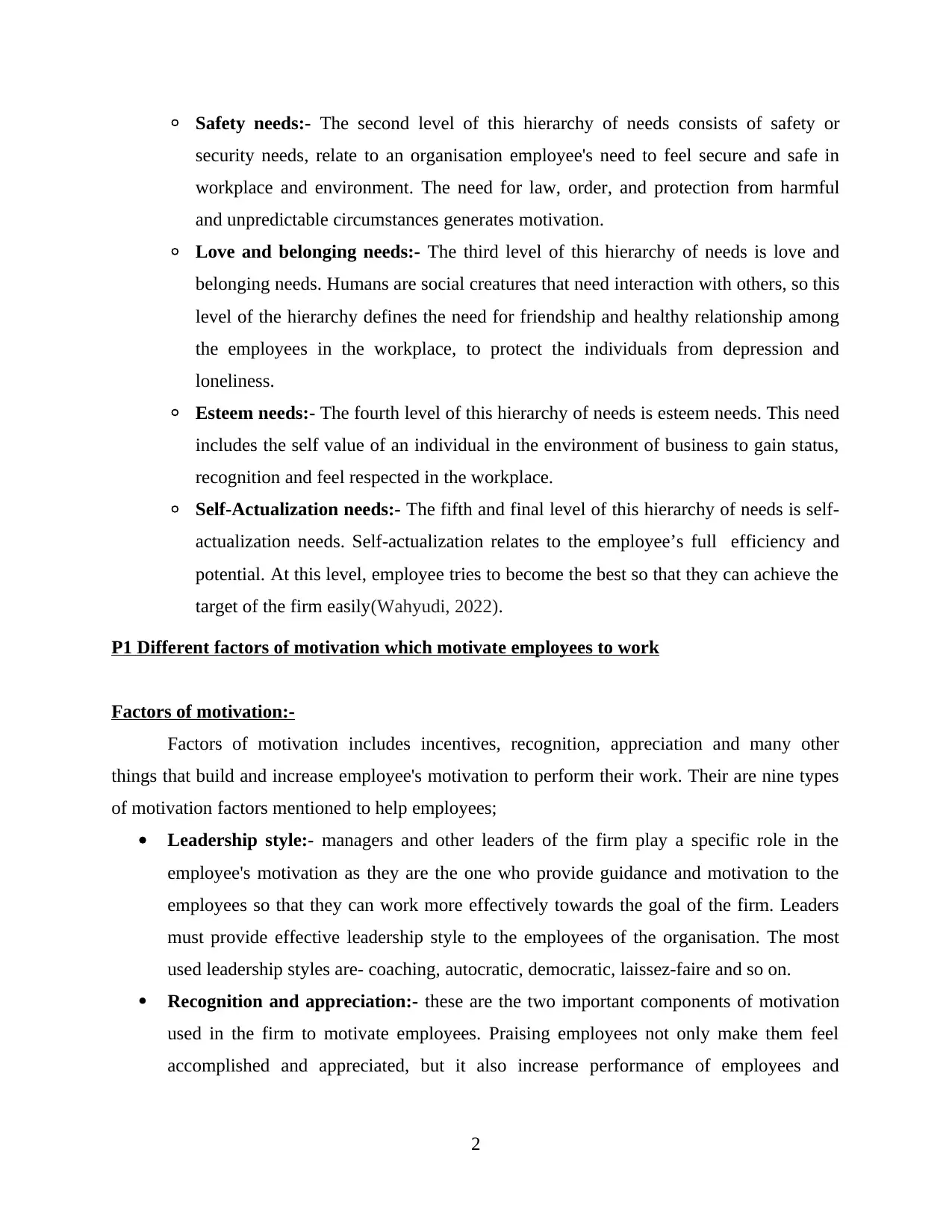
◦ Safety needs:- The second level of this hierarchy of needs consists of safety or
security needs, relate to an organisation employee's need to feel secure and safe in
workplace and environment. The need for law, order, and protection from harmful
and unpredictable circumstances generates motivation.
◦ Love and belonging needs:- The third level of this hierarchy of needs is love and
belonging needs. Humans are social creatures that need interaction with others, so this
level of the hierarchy defines the need for friendship and healthy relationship among
the employees in the workplace, to protect the individuals from depression and
loneliness.
◦ Esteem needs:- The fourth level of this hierarchy of needs is esteem needs. This need
includes the self value of an individual in the environment of business to gain status,
recognition and feel respected in the workplace.
◦ Self-Actualization needs:- The fifth and final level of this hierarchy of needs is self-
actualization needs. Self-actualization relates to the employee’s full efficiency and
potential. At this level, employee tries to become the best so that they can achieve the
target of the firm easily(Wahyudi, 2022).
P1 Different factors of motivation which motivate employees to work
Factors of motivation:-
Factors of motivation includes incentives, recognition, appreciation and many other
things that build and increase employee's motivation to perform their work. Their are nine types
of motivation factors mentioned to help employees;
Leadership style:- managers and other leaders of the firm play a specific role in the
employee's motivation as they are the one who provide guidance and motivation to the
employees so that they can work more effectively towards the goal of the firm. Leaders
must provide effective leadership style to the employees of the organisation. The most
used leadership styles are- coaching, autocratic, democratic, laissez-faire and so on.
Recognition and appreciation:- these are the two important components of motivation
used in the firm to motivate employees. Praising employees not only make them feel
accomplished and appreciated, but it also increase performance of employees and
2
security needs, relate to an organisation employee's need to feel secure and safe in
workplace and environment. The need for law, order, and protection from harmful
and unpredictable circumstances generates motivation.
◦ Love and belonging needs:- The third level of this hierarchy of needs is love and
belonging needs. Humans are social creatures that need interaction with others, so this
level of the hierarchy defines the need for friendship and healthy relationship among
the employees in the workplace, to protect the individuals from depression and
loneliness.
◦ Esteem needs:- The fourth level of this hierarchy of needs is esteem needs. This need
includes the self value of an individual in the environment of business to gain status,
recognition and feel respected in the workplace.
◦ Self-Actualization needs:- The fifth and final level of this hierarchy of needs is self-
actualization needs. Self-actualization relates to the employee’s full efficiency and
potential. At this level, employee tries to become the best so that they can achieve the
target of the firm easily(Wahyudi, 2022).
P1 Different factors of motivation which motivate employees to work
Factors of motivation:-
Factors of motivation includes incentives, recognition, appreciation and many other
things that build and increase employee's motivation to perform their work. Their are nine types
of motivation factors mentioned to help employees;
Leadership style:- managers and other leaders of the firm play a specific role in the
employee's motivation as they are the one who provide guidance and motivation to the
employees so that they can work more effectively towards the goal of the firm. Leaders
must provide effective leadership style to the employees of the organisation. The most
used leadership styles are- coaching, autocratic, democratic, laissez-faire and so on.
Recognition and appreciation:- these are the two important components of motivation
used in the firm to motivate employees. Praising employees not only make them feel
accomplished and appreciated, but it also increase performance of employees and
2
Paraphrase This Document
Need a fresh take? Get an instant paraphrase of this document with our AI Paraphraser
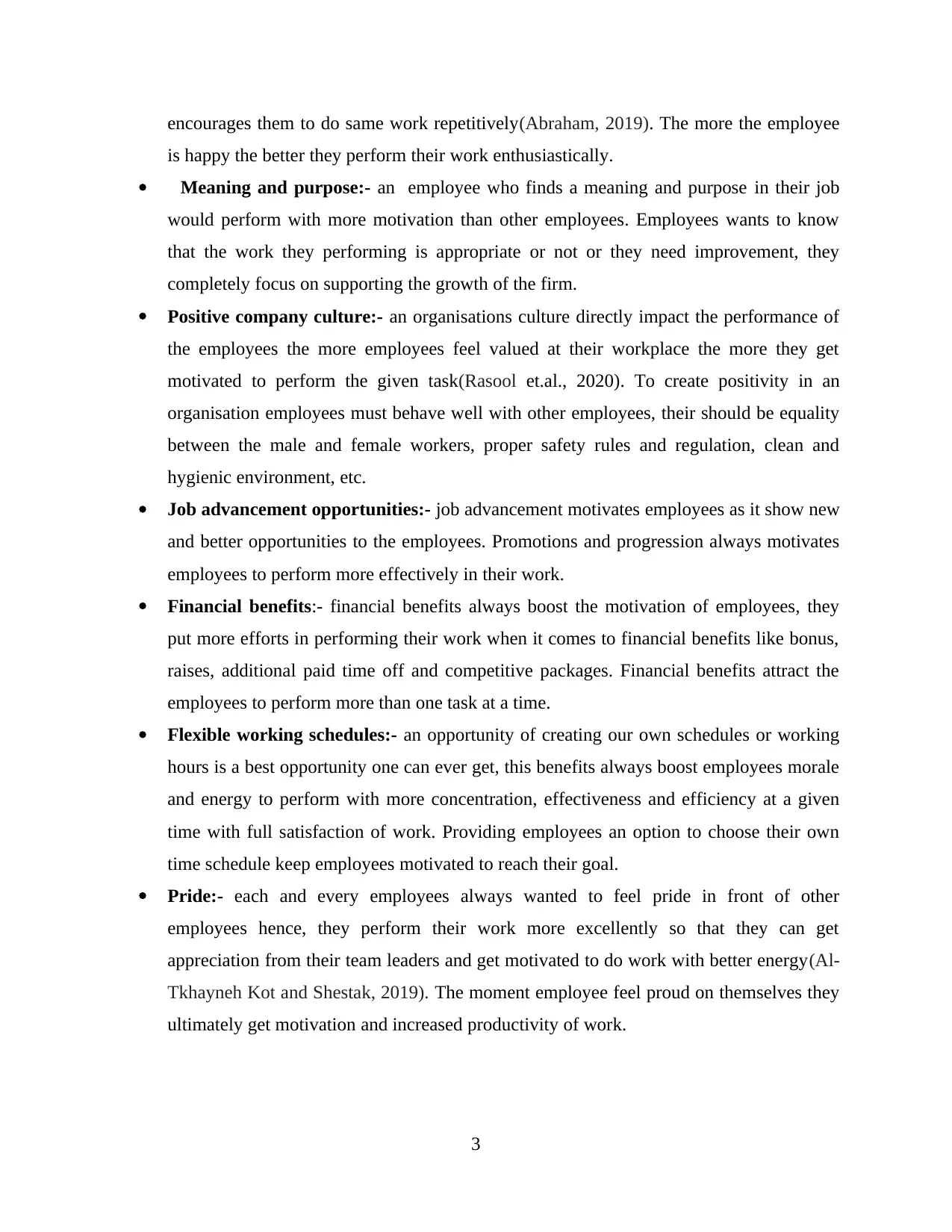
encourages them to do same work repetitively(Abraham, 2019). The more the employee
is happy the better they perform their work enthusiastically.
Meaning and purpose:- an employee who finds a meaning and purpose in their job
would perform with more motivation than other employees. Employees wants to know
that the work they performing is appropriate or not or they need improvement, they
completely focus on supporting the growth of the firm.
Positive company culture:- an organisations culture directly impact the performance of
the employees the more employees feel valued at their workplace the more they get
motivated to perform the given task(Rasool et.al., 2020). To create positivity in an
organisation employees must behave well with other employees, their should be equality
between the male and female workers, proper safety rules and regulation, clean and
hygienic environment, etc.
Job advancement opportunities:- job advancement motivates employees as it show new
and better opportunities to the employees. Promotions and progression always motivates
employees to perform more effectively in their work.
Financial benefits:- financial benefits always boost the motivation of employees, they
put more efforts in performing their work when it comes to financial benefits like bonus,
raises, additional paid time off and competitive packages. Financial benefits attract the
employees to perform more than one task at a time.
Flexible working schedules:- an opportunity of creating our own schedules or working
hours is a best opportunity one can ever get, this benefits always boost employees morale
and energy to perform with more concentration, effectiveness and efficiency at a given
time with full satisfaction of work. Providing employees an option to choose their own
time schedule keep employees motivated to reach their goal.
Pride:- each and every employees always wanted to feel pride in front of other
employees hence, they perform their work more excellently so that they can get
appreciation from their team leaders and get motivated to do work with better energy(Al-
Tkhayneh Kot and Shestak, 2019). The moment employee feel proud on themselves they
ultimately get motivation and increased productivity of work.
3
is happy the better they perform their work enthusiastically.
Meaning and purpose:- an employee who finds a meaning and purpose in their job
would perform with more motivation than other employees. Employees wants to know
that the work they performing is appropriate or not or they need improvement, they
completely focus on supporting the growth of the firm.
Positive company culture:- an organisations culture directly impact the performance of
the employees the more employees feel valued at their workplace the more they get
motivated to perform the given task(Rasool et.al., 2020). To create positivity in an
organisation employees must behave well with other employees, their should be equality
between the male and female workers, proper safety rules and regulation, clean and
hygienic environment, etc.
Job advancement opportunities:- job advancement motivates employees as it show new
and better opportunities to the employees. Promotions and progression always motivates
employees to perform more effectively in their work.
Financial benefits:- financial benefits always boost the motivation of employees, they
put more efforts in performing their work when it comes to financial benefits like bonus,
raises, additional paid time off and competitive packages. Financial benefits attract the
employees to perform more than one task at a time.
Flexible working schedules:- an opportunity of creating our own schedules or working
hours is a best opportunity one can ever get, this benefits always boost employees morale
and energy to perform with more concentration, effectiveness and efficiency at a given
time with full satisfaction of work. Providing employees an option to choose their own
time schedule keep employees motivated to reach their goal.
Pride:- each and every employees always wanted to feel pride in front of other
employees hence, they perform their work more excellently so that they can get
appreciation from their team leaders and get motivated to do work with better energy(Al-
Tkhayneh Kot and Shestak, 2019). The moment employee feel proud on themselves they
ultimately get motivation and increased productivity of work.
3
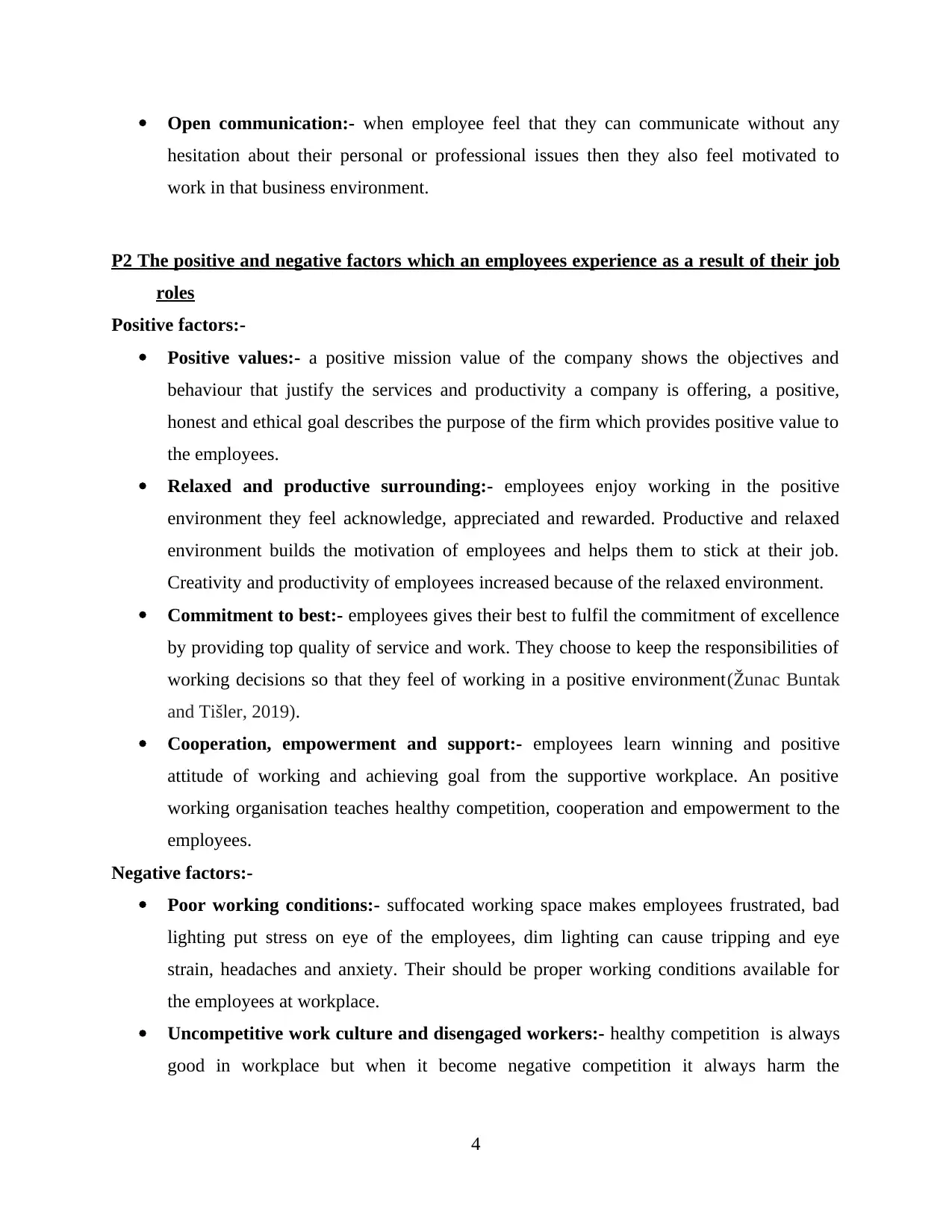
Open communication:- when employee feel that they can communicate without any
hesitation about their personal or professional issues then they also feel motivated to
work in that business environment.
P2 The positive and negative factors which an employees experience as a result of their job
roles
Positive factors:-
Positive values:- a positive mission value of the company shows the objectives and
behaviour that justify the services and productivity a company is offering, a positive,
honest and ethical goal describes the purpose of the firm which provides positive value to
the employees.
Relaxed and productive surrounding:- employees enjoy working in the positive
environment they feel acknowledge, appreciated and rewarded. Productive and relaxed
environment builds the motivation of employees and helps them to stick at their job.
Creativity and productivity of employees increased because of the relaxed environment.
Commitment to best:- employees gives their best to fulfil the commitment of excellence
by providing top quality of service and work. They choose to keep the responsibilities of
working decisions so that they feel of working in a positive environment(Žunac Buntak
and Tišler, 2019).
Cooperation, empowerment and support:- employees learn winning and positive
attitude of working and achieving goal from the supportive workplace. An positive
working organisation teaches healthy competition, cooperation and empowerment to the
employees.
Negative factors:-
Poor working conditions:- suffocated working space makes employees frustrated, bad
lighting put stress on eye of the employees, dim lighting can cause tripping and eye
strain, headaches and anxiety. Their should be proper working conditions available for
the employees at workplace.
Uncompetitive work culture and disengaged workers:- healthy competition is always
good in workplace but when it become negative competition it always harm the
4
hesitation about their personal or professional issues then they also feel motivated to
work in that business environment.
P2 The positive and negative factors which an employees experience as a result of their job
roles
Positive factors:-
Positive values:- a positive mission value of the company shows the objectives and
behaviour that justify the services and productivity a company is offering, a positive,
honest and ethical goal describes the purpose of the firm which provides positive value to
the employees.
Relaxed and productive surrounding:- employees enjoy working in the positive
environment they feel acknowledge, appreciated and rewarded. Productive and relaxed
environment builds the motivation of employees and helps them to stick at their job.
Creativity and productivity of employees increased because of the relaxed environment.
Commitment to best:- employees gives their best to fulfil the commitment of excellence
by providing top quality of service and work. They choose to keep the responsibilities of
working decisions so that they feel of working in a positive environment(Žunac Buntak
and Tišler, 2019).
Cooperation, empowerment and support:- employees learn winning and positive
attitude of working and achieving goal from the supportive workplace. An positive
working organisation teaches healthy competition, cooperation and empowerment to the
employees.
Negative factors:-
Poor working conditions:- suffocated working space makes employees frustrated, bad
lighting put stress on eye of the employees, dim lighting can cause tripping and eye
strain, headaches and anxiety. Their should be proper working conditions available for
the employees at workplace.
Uncompetitive work culture and disengaged workers:- healthy competition is always
good in workplace but when it become negative competition it always harm the
4
⊘ This is a preview!⊘
Do you want full access?
Subscribe today to unlock all pages.

Trusted by 1+ million students worldwide
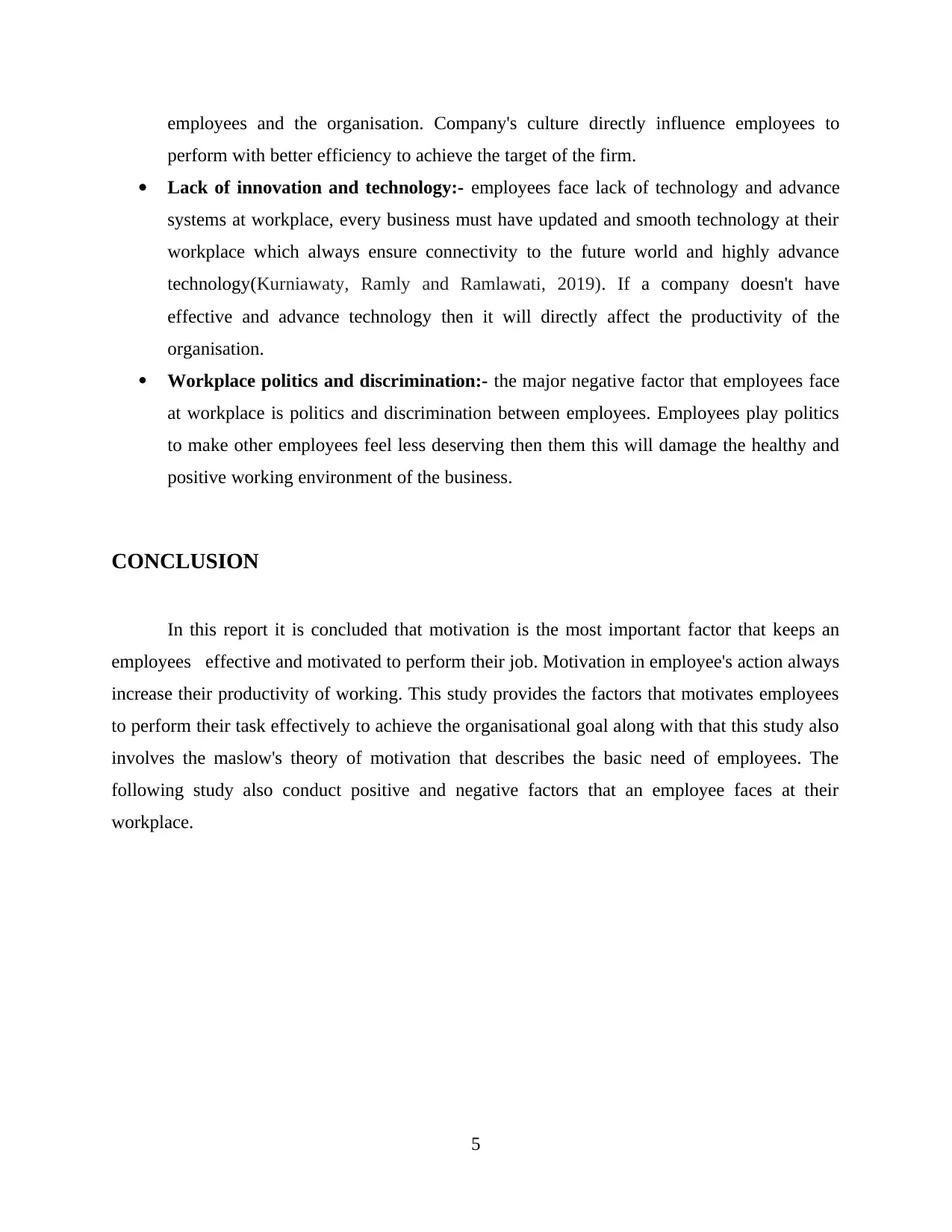
employees and the organisation. Company's culture directly influence employees to
perform with better efficiency to achieve the target of the firm.
Lack of innovation and technology:- employees face lack of technology and advance
systems at workplace, every business must have updated and smooth technology at their
workplace which always ensure connectivity to the future world and highly advance
technology(Kurniawaty, Ramly and Ramlawati, 2019). If a company doesn't have
effective and advance technology then it will directly affect the productivity of the
organisation.
Workplace politics and discrimination:- the major negative factor that employees face
at workplace is politics and discrimination between employees. Employees play politics
to make other employees feel less deserving then them this will damage the healthy and
positive working environment of the business.
CONCLUSION
In this report it is concluded that motivation is the most important factor that keeps an
employees effective and motivated to perform their job. Motivation in employee's action always
increase their productivity of working. This study provides the factors that motivates employees
to perform their task effectively to achieve the organisational goal along with that this study also
involves the maslow's theory of motivation that describes the basic need of employees. The
following study also conduct positive and negative factors that an employee faces at their
workplace.
5
perform with better efficiency to achieve the target of the firm.
Lack of innovation and technology:- employees face lack of technology and advance
systems at workplace, every business must have updated and smooth technology at their
workplace which always ensure connectivity to the future world and highly advance
technology(Kurniawaty, Ramly and Ramlawati, 2019). If a company doesn't have
effective and advance technology then it will directly affect the productivity of the
organisation.
Workplace politics and discrimination:- the major negative factor that employees face
at workplace is politics and discrimination between employees. Employees play politics
to make other employees feel less deserving then them this will damage the healthy and
positive working environment of the business.
CONCLUSION
In this report it is concluded that motivation is the most important factor that keeps an
employees effective and motivated to perform their job. Motivation in employee's action always
increase their productivity of working. This study provides the factors that motivates employees
to perform their task effectively to achieve the organisational goal along with that this study also
involves the maslow's theory of motivation that describes the basic need of employees. The
following study also conduct positive and negative factors that an employee faces at their
workplace.
5
Paraphrase This Document
Need a fresh take? Get an instant paraphrase of this document with our AI Paraphraser
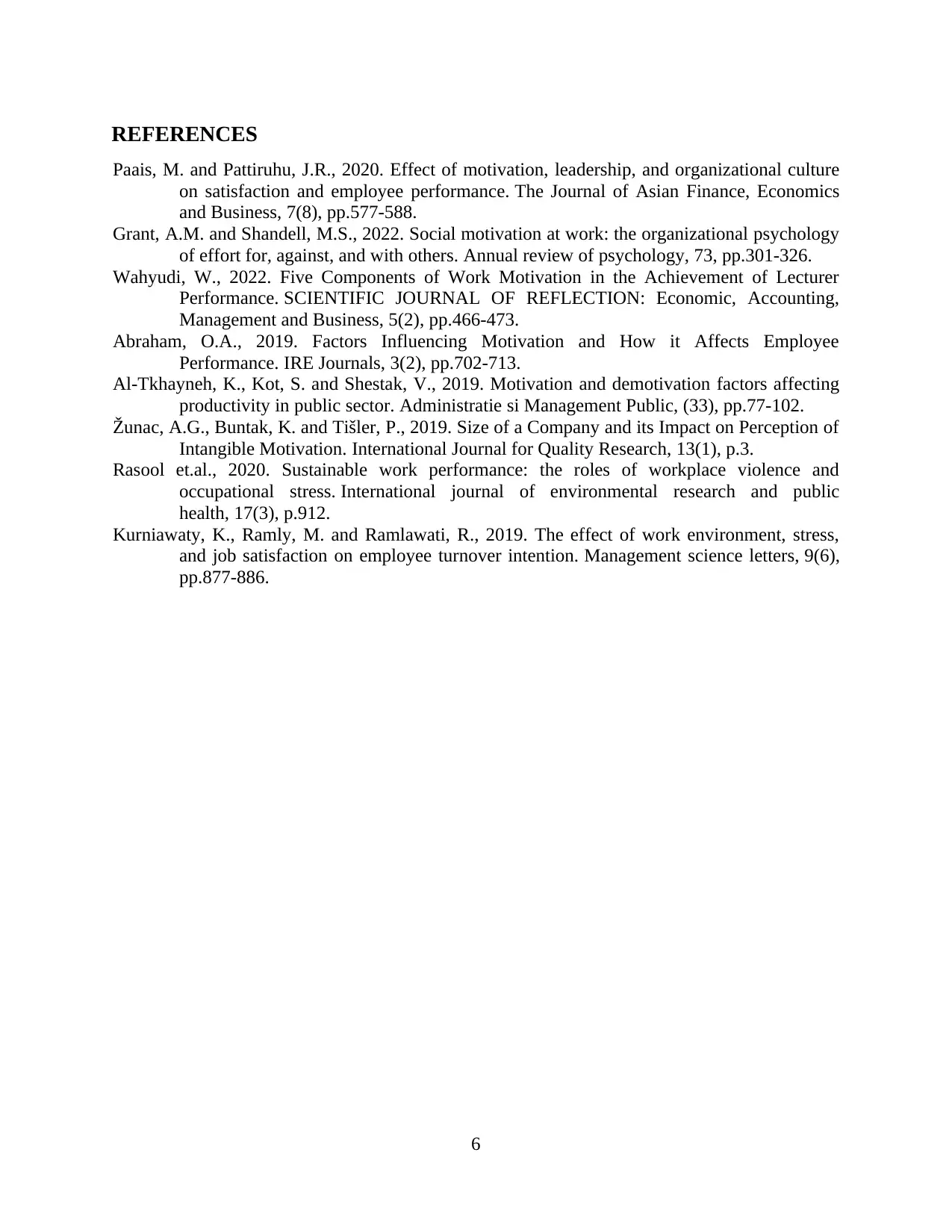
REFERENCES
Paais, M. and Pattiruhu, J.R., 2020. Effect of motivation, leadership, and organizational culture
on satisfaction and employee performance. The Journal of Asian Finance, Economics
and Business, 7(8), pp.577-588.
Grant, A.M. and Shandell, M.S., 2022. Social motivation at work: the organizational psychology
of effort for, against, and with others. Annual review of psychology, 73, pp.301-326.
Wahyudi, W., 2022. Five Components of Work Motivation in the Achievement of Lecturer
Performance. SCIENTIFIC JOURNAL OF REFLECTION: Economic, Accounting,
Management and Business, 5(2), pp.466-473.
Abraham, O.A., 2019. Factors Influencing Motivation and How it Affects Employee
Performance. IRE Journals, 3(2), pp.702-713.
Al-Tkhayneh, K., Kot, S. and Shestak, V., 2019. Motivation and demotivation factors affecting
productivity in public sector. Administratie si Management Public, (33), pp.77-102.
Žunac, A.G., Buntak, K. and Tišler, P., 2019. Size of a Company and its Impact on Perception of
Intangible Motivation. International Journal for Quality Research, 13(1), p.3.
Rasool et.al., 2020. Sustainable work performance: the roles of workplace violence and
occupational stress. International journal of environmental research and public
health, 17(3), p.912.
Kurniawaty, K., Ramly, M. and Ramlawati, R., 2019. The effect of work environment, stress,
and job satisfaction on employee turnover intention. Management science letters, 9(6),
pp.877-886.
6
Paais, M. and Pattiruhu, J.R., 2020. Effect of motivation, leadership, and organizational culture
on satisfaction and employee performance. The Journal of Asian Finance, Economics
and Business, 7(8), pp.577-588.
Grant, A.M. and Shandell, M.S., 2022. Social motivation at work: the organizational psychology
of effort for, against, and with others. Annual review of psychology, 73, pp.301-326.
Wahyudi, W., 2022. Five Components of Work Motivation in the Achievement of Lecturer
Performance. SCIENTIFIC JOURNAL OF REFLECTION: Economic, Accounting,
Management and Business, 5(2), pp.466-473.
Abraham, O.A., 2019. Factors Influencing Motivation and How it Affects Employee
Performance. IRE Journals, 3(2), pp.702-713.
Al-Tkhayneh, K., Kot, S. and Shestak, V., 2019. Motivation and demotivation factors affecting
productivity in public sector. Administratie si Management Public, (33), pp.77-102.
Žunac, A.G., Buntak, K. and Tišler, P., 2019. Size of a Company and its Impact on Perception of
Intangible Motivation. International Journal for Quality Research, 13(1), p.3.
Rasool et.al., 2020. Sustainable work performance: the roles of workplace violence and
occupational stress. International journal of environmental research and public
health, 17(3), p.912.
Kurniawaty, K., Ramly, M. and Ramlawati, R., 2019. The effect of work environment, stress,
and job satisfaction on employee turnover intention. Management science letters, 9(6),
pp.877-886.
6
1 out of 8
Related Documents
Your All-in-One AI-Powered Toolkit for Academic Success.
+13062052269
info@desklib.com
Available 24*7 on WhatsApp / Email
![[object Object]](/_next/static/media/star-bottom.7253800d.svg)
Unlock your academic potential
Copyright © 2020–2025 A2Z Services. All Rights Reserved. Developed and managed by ZUCOL.


